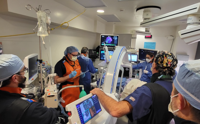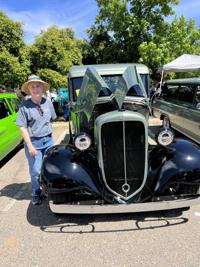Mercy Medical Center in Redding is the only location between Sacramento and Portland offering this life-saving procedure using what they call the Ion Robotic Lung Program.
REDDING, Calif. - For this week’s Wellness Wednesday segment, Action News Now anchor Alan Marsden showed us how remarkable new technology is helping Mercy Medical Center detect lung cancer.
In Northern California, lung cancer ranks among the top two tumor cancers diagnosed every year.
And as with many types of cancer, the longer it goes undiagnosed, the smaller the chances of survival.
Mercy Medical Center in Redding is the only location between Sacramento and Portland offering this life-saving procedure using what they call the Ion Robotic Lung Program.
The Ion Robotic Lung Program is a spinning 3D C-T machine that is used to diagnose lung cancer earlier than ever.
Marsden spoke with Dr. Rafael Lupercio, who is putting this new technology to use.
"So without this system before, it was extremely difficult to get at it. So basically, you had to get a CT scan, and if there's a nodule, wait until it gets big enough you can get at it, or take it out without knowing if it's a cancer or not. With this, we have a 95% chance of getting to the nodule and make a diagnosis,” Dr. Lupercio said.

Dr. Lupercio said the technology works by sending a probe through the patient's mouth, allowing the ion robot to navigate deep into the lungs to get tissue samples, allowing doctors to find masses for biopsy that were previously unreachable.
"So the earlier stage you find the cancer, the more options. If you take it out and it's localized, there's a very good chance the person's going to be cured—not treated, cured,” Dr. Lupercio said.
Without this new technology, the prognosis for patients can be grim. Dr. Lupercio said that currently, 80% of all lung cancer diagnoses are either stage 3 or stage 4. The five-year survival rate ranges from 5% to 40%.
The key to beating those odds is early screening. Dr. Lupercio said early screening can be the difference between life and death.
"The first thing if they are smokers, the first thing I will say is stop. It's never too late to stop. Nothing good comes out of smoking, ever. And second, get a screening,” Dr. Lupercio said.
That screening determines if you should go through the ion robotic lung program.
But you must first be eligible for a screening. Typically, you qualify if you are over the age of 50 and have smoked a pack a day for 20 years.
Dr. Lupercio said he's performed this procedure about 80 times. In 80% of those cases, malignant tumors were discovered. 5% of the cases resulted in a diagnosis other than cancer.














